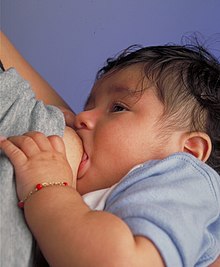Blocked milk duct
| Blocked milk duct | |
|---|---|
| Other names | Clogged milk duct |
A blocked milk duct (sometimes also called plugged or clogged milk duct) is a blockage of one or more ducts carrying milk to the nipple for the purpose of breastfeeding an infant that can cause mastitis. The symptoms are a tender, localised lump in one breast, with redness in the skin over the lump. The cause of a blocked milk duct is the failure to remove milk from part of the breast. This may be due to infrequent breastfeeding, poor attachment, tight clothing or trauma to the breast. Sometimes the duct to one part of the breast is blocked by thickened milk. A blocked milk duct can be managed by improving the removal of milk and correcting the underlying cause.[1]
Symptoms and signs
A blocked milk duct has the following common symptoms:[2][3]
- Low fever and breast infection
- Pain in a particular side of the breast
- Swollen or tender lump in the breast
- Slower milk flow
- a small white blister on the nipple called a milk bleb
- swelling or redness of the breast
- areas of the breast that are hot or warm to touch
- the infant may feel fussy when feeding from the affected breast
Causes

Blocked milk ducts are a common breastfeeding problem and can be caused due to a number of reasons:[2][4]
- When the infant does not latch properly
- Wearing a tight bra or tight clothing can restrict the breasts and put pressure on them leading to a blocked milk duct
- A bad or weak pump could lead to a drainage issue
- When the breast milk is not removed regularly, the milk can back up and create a blockage
- A nipple bleb can also block the milk duct
- When the body produces milk in over abundance, it can engorge the breast and hence lead to a blockage
- Lactiferous Duct Dysmorphia, or, the deformation of the milk duct due to elastic skin pulled too far into a flange. As the skin stretches, the duct can become too thin for milk to pass through, causing a clog or blockage.
- Other reasons include fatigue, over exercise, dehydration and weaning.
Diagnosis
This section is empty. You can help by adding to it. (September 2023) |
Treatment
The most effective treatment against blocked milk ducts is to empty the affected breasts by frequent breastfeeding or pumping.[5] Numerous other treatment approaches have been suggested, however, there is insufficient clinical research to determine the effectiveness. Treatments that have been studied but have no strong evidence for or against their use:
- A gentle massage of the affected breast[6] Sometimes after gentle massage over the lump, a string of the thickened milk comes out through the nipple, followed by a stream of milk, and rapid relief of the blocked duct.[1]
- Ensuring a correct positioning and latching of the baby[6]
- Wearing loose clothing items that do not bind the breasts[7]
- Applying warm compresses[6]
- Drinking a specialized herbal tea[7]
- Acupuncture[6]
- Gua-Sha[6]
- Proteolytic enzymes[6]
A blocked milk duct can result from a nipple bleb. Both of these can lead to mastitis.[8]
References
- ^ a b "Management of breast conditions and other breastfeeding difficulties". National Center for Biotechnology Information US National Library of Medicine. Retrieved 4 August 2017.
 This article incorporates text from this source, which is in the public domain.
This article incorporates text from this source, which is in the public domain.
- ^ a b "Clogged Milk Ducts: Symptoms, Causes and Treatments". www.thebump.com. Retrieved 2019-09-21.
- ^ "Reasons for blocked ducts". Medela. Retrieved 2019-09-21.
- ^ "Clogged milk duct: Symptoms, home remedies, and prevention". Medical News Today. 3 September 2018. Retrieved 2019-09-21.
- ^ Roberts, Kathryn L.; Reiter, Maureen; Schuster, Diane (September 1998). "Effects of Cabbage Leaf Extract on Breast Engorgement". Journal of Human Lactation. 14 (3): 231–236. doi:10.1177/089033449801400312. ISSN 0890-3344. PMID 10205435. S2CID 13110956.
- ^ a b c d e f Zakarija-Grkovic, Irena; Stewart, Fiona (18 September 2020). "Treatments for breast engorgement during lactation". The Cochrane Database of Systematic Reviews. 2020 (9): CD006946. doi:10.1002/14651858.CD006946.pub4. ISSN 1469-493X. PMC 8094412. PMID 32944940.
- ^ a b "Tackling engorgement and mastitis: an all-in-one guide". www.meandqi.com. Retrieved 2019-03-26.
- ^ Walker, Marsha (2011). Breastfeeding management for the clinician : using the evidence. Sudbury, Mass: Jones and Bartlett Publishers. p. s 534–5. ISBN 9780763766511.
